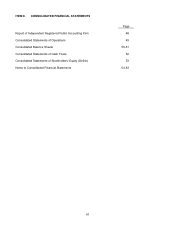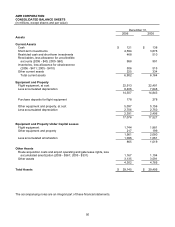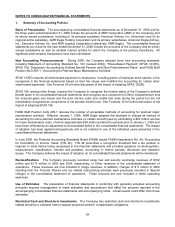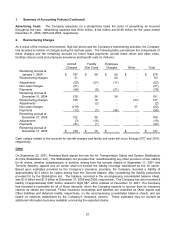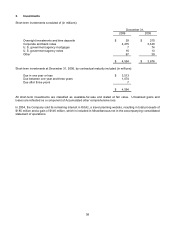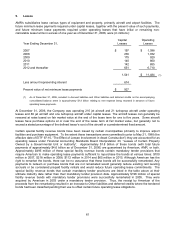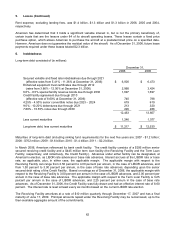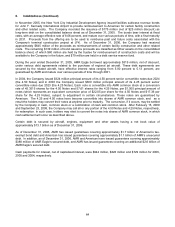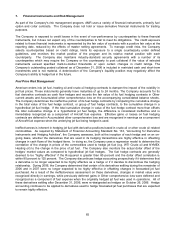American Airlines 2006 Annual Report Download - page 60
Download and view the complete annual report
Please find page 60 of the 2006 American Airlines annual report below. You can navigate through the pages in the report by either clicking on the pages listed below, or by using the keyword search tool below to find specific information within the annual report.56
1. Summary of Accounting Policies (Continued)
Effective January 1, 2005, in order to more accurately reflect the expected useful life of its aircraft, the Company
changed its estimate of the depreciable lives of its Boeing 737-800, Boeing 757-200 and McDonnell Douglas MD-
80 aircraft from 25 to 30 years. As a result of this change, Depreciation and amortization expense was reduced
by approximately $108 million in each of the years ended December 31, 2006 and 2005, and per share net
income for 2006 was approximately $0.41 more than it otherwise would have been and the per share net loss for
2005 was approximately $0.65 less than it otherwise would have been.
Residual values for aircraft, engines, major rotable parts, avionics and assemblies are generally five to ten
percent, except when guaranteed by a third party for a different amount.
Equipment and property under capital leases are amortized over the term of the leases or, in the case of certain
aircraft, over their expected useful lives. Lease terms vary but are generally ten to 25 years for aircraft and seven
to 40 years for other leased equipment and property.
Regional Affiliates Revenue from ticket sales is generally recognized when service is provided. Regional
Affiliates revenues for flights connecting to American flights are allocated based on industry standard proration
agreements.
Passenger Revenue Passenger ticket sales are initially recorded as a component of Air traffic liability.
Revenue derived from ticket sales is recognized at the time service is provided. However, due to various factors,
including the complex pricing structure and interline agreements throughout the industry, certain amounts are
recognized in revenue using estimates regarding both the timing of the revenue recognition and the amount of
revenue to be recognized, including breakage. These estimates are generally based upon the evaluation of
historical trends, including the use of regression analysis and other methods to model the outcome of future
events based on the Company’s historical experience, and are recorded at the scheduled time of departure.
Frequent Flyer Program The estimated incremental cost of providing free travel awards is accrued for mileage
credits earned by using American’s service that are expected to be redeemed in the future. American also
accrues a frequent flyer liability for the mileage credits that are expected to be used for travel on participating
airlines based on historical usage patterns and contractual rates. American sells mileage credits and related
services to companies participating in its frequent flyer program. The portion of the revenue related to the sale of
mileage credits, representing the revenue for air transportation sold, is valued at current market rates and is
deferred and amortized over 28 months, which approximates the expected period over which the mileage credits
are used. Breakage of sold miles is recognized over the estimated period of usage. The remaining portion of the
revenue, representing the marketing services sold and administrative costs associated with operating the
AAdvantage program, is recognized upon sale as a component of passenger revenues, as the related services
have been provided. The Company recognizes this revenue in passenger revenue because it is derived from the
value of the Company’s AAdvantage passengers. The Company’s total liability for future AAdvantage award
redemptions for free, discounted or upgraded travel on American, American Eagle or participating airlines as well
as unrecognized revenue from selling AAdvantage miles was approximately $1.6 billion and $1.5 billion (and is
recorded as a component of Air traffic liability on the accompanying consolidated balance sheets) at December
31, 2006 and 2005, respectively. At December 31, 2006, the Company implemented certain changes in the
estimates it uses to calculate the frequent flyer liability. These changes in estimate, which did not have a material
impact on the liability at December 31, 2006, primarily related to valuing all program miles and the associated
breakage estimates and to consider recent changes in trends for expiring miles.
Income Taxes The Company has reserves for taxes and associated interest that may become payable in future
years as a result of audits by tax authorities. Although the Company believes that the positions taken on
previously filed tax returns are reasonable, it nevertheless has established tax and interest reserves in recognition
that various taxing authorities may challenge the positions taken by the Company resulting in additional liabilities
for taxes and interest. The tax reserves are reviewed as circumstances warrant and adjusted as events occur
that affect the Company’s potential liability for additional taxes, such as lapsing of applicable statutes of
limitations, conclusion of tax audits, additional exposure based on current calculations, identification of new
issues, release of administrative guidance, or rendering of a court decision affecting a particular tax issue.



